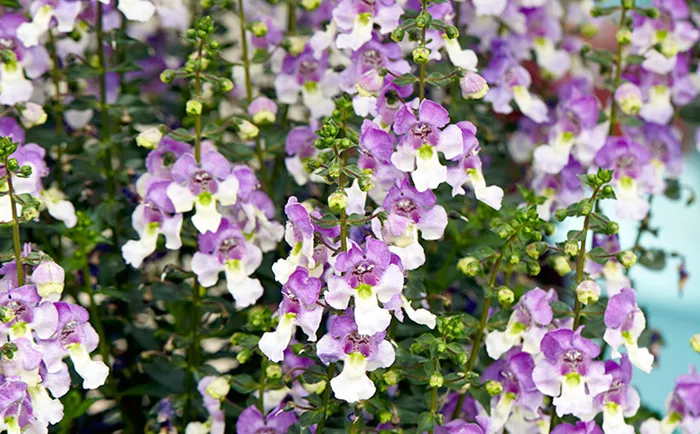Deadheading is the task of removing old, faded flowers to help plants grow new ones. Like pruning, it’s a common way to keep gardens tidy and productive. But for many gardeners, deadheading feels like extra work.
Fortunately, some plants take care of that on their own.
These self-cleaning flowers drop their old blooms naturally, making room for fresh ones without any effort from you. They thrive in various climates and need little care to flourish—though occasional pruning can help control their shape.
Here are 17 beautiful and self-cleaning flowers perfect for low-maintenance gardens:
1. Cuphea
Cuphea grows in warm climates (zones 9–11) and produces bold, bright flowers. These plants need sun, well-draining soil, and regular watering. They bloom continuously without deadheading but may attract pests. Keeping bugs away will help them stay healthy.
2. Nemesia
Nemesia grows from zones 2 to 11 and comes in many colors. Hybrids like ‘Sunsatia’ and ‘Aromance’ are especially vibrant. These plants prefer sunny spots and rich soil. They are self-cleaning and bloom non-stop through the growing season.
3. Million Bells (Calibrachoa)
Often called trailing petunia, this flower grows well in zones 7 to 11. It blooms in many colors, thrives in full sun and rich soil, and never needs deadheading. Million bells are perfect for hanging baskets or containers.
4. Cape Mallow
This shrubby flower grows in zones 8 to 11. Cape mallow loves dry, well-drained soil and sun. It’s heat and drought-tolerant and naturally drops faded flowers. Smaller types like ‘Slightly Strawberry’ work great in pots.
5. Browallia
Known as sapphire or amethyst flower, browallia is native to South America and does well in zones 9 to 11. It likes morning sun, moist soil, and afternoon shade. Its star-shaped blooms don’t need deadheading, though you can pinch them to grow fuller plants.
6. Dwarf Morning Glory
This fast-growing ground cover grows in zones 8 to 11. With baby-blue blooms and dense green leaves, dwarf morning glory thrives in full sun and well-drained soil. It’s self-cleaning and drought-tolerant, but the flowers are delicate and need gentle handling.
7. Coneflower (Echinacea)
A favorite in U.S. gardens, coneflowers are hardy from zones 3 to 8. They’re easy to grow, tolerate tough conditions, and reseed naturally. Spent flowers will fall off and often rebloom without help.
8. Begonias (Certain Cultivars)
Some begonia varieties are self-cleaning. They thrive in zones 10 to 11 with moist soil and shade. While beautiful, be cautious—these plants are toxic to pets and mildly harmful to humans. Also, some cultivars may become invasive in certain areas.
9. Angelonia
Angelonia grows in zones 9 to 11 and prefers full sun. It blooms continuously with tiny flowers that resemble snapdragons in shades of pink, blue, and white. Angelonia is tough, pet-safe, and great in containers.
10. False Indigo (Baptisia)
This perennial grows in zones 4 to 9. It’s native to the U.S. and features tall stems with purple, yellow, or pink flowers. Deadheading isn’t needed—the dried seed pods can even add interest. But keep in mind it’s mildly toxic and should be kept away from children.
11. Cleome (Spider Flower)
With its unique, spidery look, cleome grows in zones 10 and 11. It loves full sun and moist soil. These flowers don’t need deadheading, unless you want to stop them from spreading. They’re heat- and drought-resistant.
12. ‘Rockin” Salvia
These bright, long-blooming flowers grow in zones 9 to 11. The ‘Rockin” salvia varieties don’t require deadheading and bloom in deep magenta or blue. They’re drought-tolerant and sun-loving—great for year-round color in warmer regions.
13. Sedum (Stonecrop)
Sedum grows in zones 3 to 9 and offers many low-maintenance options. Some types drop their blooms, while others keep them for fall decoration. Sedum needs full sun, well-drained soil, and little water. It’s an ideal plant for hot, dry areas.
14. Diascia
Diascia grows in zones 8 to 11. Its flowers don’t need deadheading, though pinching helps shape the plant. These flowers thrive in sun and well-drained soil. They bloom in shades like pink, white, and orange, and look great in pots or rock gardens.
15. Astilbe
Astilbe japonica grows in zones 4 to 9 and prefers moist, rich soil and shade. These fluffy flowers come in red, white, or pink. Deadheading isn’t required and doesn’t affect blooming. Astilbe is great for shady walkways or container gardens.
16. Zinnia (Certain Cultivars)
Some zinnias, especially hybrid types, are self-cleaning. They grow quickly in sunny spots with good soil. Zinnias come in bold colors and bloom all summer long. They’re great for pollinators and easy for beginners.
17. Lantana
Lantana grows best in zones 8 to 11. It’s heat- and drought-tolerant and produces small, colorful clusters of flowers. These plants drop their old blooms on their own and attract butterflies. However, they can be invasive in warm climates.
Conclusion
If youlove flowers but not the upkeep, self-cleaning plants are your best bet. They save time, reduce work, and still deliver colorful blooms all season long. Whether you want a burst of color in a pot or a flowerbed that takes care of itself, these 17 varieties are easy, beautiful choices for your garden.
Let your plants do the cleaning—so you can enjoy the blooming.


